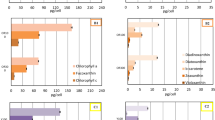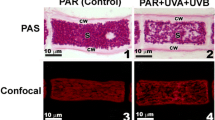Abstract
One of the consequences of ultraviolet radiation exposure in anthozoans possessing photosynthetic endosymbionts (i.e., zooxanthellae) is production of reactive oxygen species that can damage cellular components, especially lipids and photosynthetic membranes. It is well known that carotenoids are potent antioxidants that can mitigate oxygen radical damage, but the origin of these compounds in zooxanthellate anthozoans is obscured because they can potentially originate from endosymbionts, heterotrophic feeding by the host, or a combination thereof. We used Aiptasia pallida, a common Caribbean anemone, to investigate the effects of exogenous food sources, ultraviolet-A radiation (UVA, 320–400 nm), and photosynthetically active radiation (PAR, 400–700 nm) on carotenoid levels in zooxanthellate anthozoans. Anemones were exposed to one of three simulated light treatments in the laboratory for 38 days: PAR (60% below ambient)/UVA (similar to ambient), PAR/low UVA (42% below ambient), and low PAR (98.4% below ambient)/no UVA. In addition, anemones were either fed a carotenoid-rich diet of Artemia salina nauplii, or starved. Carotenoids identified in A. pallida included peridinin, diadinoxanthin, diatoxanthin and β-carotene. While a diet of Ar. salina nauplii had no effect on the carotenoid composition of A. pallida, a two-way analysis of variance revealed that anemones exposed to ambient UVA levels had significantly greater diatoxanthin concentrations relative to the total xanthophyll pool [diato:(diato+diadino)] after 10 days of exposure. This difference among treatments was not present at 20 days, but reappeared as an effect due to starvation rather than UVA at days 30 and 38. These results suggest that carotenoids in A. pallida are not influenced by exogenous feeding and that photoprotective xanthophyll cycling is sensitive to stresses such as UVA and starvation.






Similar content being viewed by others
References
Ahmadi MR, Leibovitz H, Simpson KL (1990) Nutrient composition of the Iranian brine shrimp (Artemia uromiana). Comp Biochem Physiol B 95:225–228
Ambarsari I, Barlow RG, Britton NG, Cummings D (1997) Fluctuations in algal chlorophyll and carotenoid pigments during solar bleaching in the coral Goniastrea aspera at Phuket, Thailand. Mar Ecol Prog Ser 159:303–307
Baker K, Smith RC, Green AES (1980) Middle ultraviolet reaching the ocean surface. Photochem Photobiol 32:367–374
Bradford MM (1976) A rapid and sensitive method for the quantitation of microgram quantities of protein utilizing the principle of protein-dye binding. Anal Biochem 72:248–254
Brown BE, Ambarsari I, Warner ME, Fitt WK, Dunne RP, Gibb SW, Cummings D (1999) Diurnal changes in photochemical efficiency and xanthophyll concentrations in shallow water reef corals: evidence for photoinhibition and photoprotection. Coral Reefs 18:99–106
Clayton WS, Lasker HR (1984) Host feeding regime and zooxanthellal photosynthesis in the anemone, Aiptasia pallida (Verrill). Biol Bull 167:590–600
Cockell CS, Knowland J (1999) Ultraviolet radiation screening compounds. Biol Rev 74: 311–345
Davies PS (1997) Anthozoan endosymbiosis. Proc Sixth Int Conf on Coelenterate Biology, pp 125–134
Demers S, Roy R, Gagnon R, Vignault C (1991) Rapid light-induced changes in cell fluorescence and in xanthophyll-cycle pigments of Alexandrium excavatum (Dinophyceae) and Thalassiosira pseudonana (Bacillariophyceae): a photoprotection mechanism. Mar Ecol Prog Ser 76:185–193
Falkowski PG, Jokiel PL, Kinzie RA, III (1990) Irradiance and corals. In: Dubinsky Z (ed) Coral reefs. Elsevier, Amsterdam, pp 89–107
Fang LS, Liao CW, Liu MC (1995) Pigment composition in different-colored scleractinian corals before and during the bleaching process. Zool Stud 34:10–17
Fitt WK (2000) Cellular growth of host and symbiont in a cnidarian-zooxanthellar symbiosis. Biol Bull 198:110–120
Fitt WK, Brown BE, Warner ME, Dunne RP (2001) Coral bleaching: interpretation of thermal tolerance limits and thermal thresholds in tropical corals. Coral Reefs 20:51–65
Fleischmann EM (1989) Measurement and penetration of ultraviolet radiation into tropical marine water. Limnol Oceanogr 34:1623–1629
Frank HA, Cua A, Chynwat V, Young AJ, Gosztola D, Wasielewski MR (1996) The lifetimes and energies of the first excited singlet states of diadinoxanthin and diatoxanthin: the role of these molecules in excess energy dissipation in algae. Biochem Biophys Acta 1277:243–252
Gleason DF, Wellington GM (1993) Ultraviolet radiation and coral bleaching. Nature 365:836–838
Goodwin TW (1980) The biochemistry of the carotenoids. vol I. Plants. Chapman and Hall, London
Goodwin TW (1984) The biochemistry of the carotenoids, vol II. Animals. Chapman & Hall, London
Götz T, Windhövel U, Böger P, Sandmann G (1999) Protection of photosynthesis against ultraviolet-B radiation by carotenoids in transformants of the cyanobacterium synechococcus PCC7942. Plant Physiol 120:599–604
Harland AD, Fixter LM, Davies PS, Anderson RA (1991) Distribution of lipids between the zooxanthellae and animal compartment in the symbiotic sea anemones Anemonia viridis: wax esters, triglycerides and fatty acids. Mar Biol 110:13–19
Hoegh-Guldberg O (1999) Climate change, coral bleaching and the future of the world's coral reefs. Mar Freshw Res 50:839–866
Hoegh-Guldberg O, Jones RJ (1999) Photoinhibition and photoprotection in symbiotic dinoflagellates from reef-building corals. Mar Ecol Prog Ser 183:73–86
Hofmann E, Wrench PM, Sharples FP, Hiller RG, Welte W, Diederichs K (1996) Structural basis of light harvesting by carotenoids: peridinin-chlorophyll-protein from Amphidinium carterae. Science 272:1788–1791
Jeffery SW, Vesk M (1997) Introduction to marine phytoplankton and their pigment signatures. In: Jeffery SW, Mantoura RFC, Wright SW (eds) Phytoplankton pigments in oceanography: guidelines to modern methods. UNESCO, Paris, pp 85–126
Jeffery SW, Wright SW (1997) Qualitative and quantitative HPLC analysis of SCOR reference algal cultures. In: Jeffery SW, Mantoura RFC, Wright SW (eds) Phytoplankton pigments in oceanography: guidelines to modern methods. UNESCO, Paris, pp 343–360
Jokiel PL, York RH Jr. (1982) Solar ultraviolet photobiology of the reef coral Pocillopora damicornis and symbiotic zooxanthellae. Bull Mar Sci 32:301–315
Kaplan EH (1982) A field guide to coral reefs of the Caribbean and Florida: a guide to the common invertebrates and fishes of Bermuda, the Bahamas, southern Florida, the West Indies, and the Caribbean coast of Central and South America. Houghton Mifflin, Boston
Kleppel GS, Frazel D, Ieper RE, Olliday DV (1988) Natural diets of zooplankton off southern California. Mar Ecol Prog Ser 49:231–241
Lesser MP (1996) Elevated temperatures and ultraviolet radiation cause oxidative stress and inhibit photosynthesis in symbiotic dinoflagellates. Limnol Oceanogr 41:271–283
Lesser MP (1997) Oxidative stress causes coral bleaching during exposure to elevated temperatures. Coral Reefs 16:187–192
Lesser MP, Shick MJ (1989) Effects of irradiance and ultraviolet radiation on photoadaptation in the zooxanthellae of Aiptasia pallida: primary production, photoinhibition, and enzymic defenses against oxygen toxicity. Mar Biol 102:243–255
Lesser MP, Stochaj WR, Tapley DW, Shick MJ (1990) Bleaching in coral reef anthozoans: effects of irradiance, ultraviolet radiation, and temperature on the activities of protective enzymes against active oxygen. Coral Reefs 8:225–232
Logan BA, Demming-Adams B, Rosenstiel TN, Adams WWI (1999) Effect of nitrogen limitation on foliar antioxidants in relationship to other metabolic characteristics. Planta 209:213–220
Muscatine L, Grossman D, Doino J (1991) Release of symbiotic algae by tropical sea anemones and corals after cold shock. Mar Ecol Prog Ser 77:233–243
Nelis HJ, Sorgeloos P, De Leenheer AP (1993) Relation of cis-transisomers of carotenoids to developmental processes. In: Packer L (ed) Carotenoids, part B. Metabolism, genetics, and biosynthesis. Academic, San Diego, pp 208–225
Odum HT, Odum EP (1954) Trophic structure and productivity of a windward coral reef community on Eniwetok Atoll. Ecol Monogr 25:201–220
Olsen VA, Owens IPF (1998) Costly sexual signals: are carotenoids rare, risky or required? Trends Evol Ecol 13:510–514
Patton JS, Burris JE (1983) Lipid synthesis and extrusion by freshly isolated zooxanthellae (symbiotic algae). Mar Biol 75:131–136
Pinto E, Catalani LH, Norberto PL, Di Mascio P, Colepicolo P (2000) Peridinin as the major biological carotenoid quencher of singlet oxygen in marine algae Gonyaulax polyedra. Biochem Biophys Res Commun 268:496–500
Porra RJ, Pfündel EE, Engel N (1997) Metabolism and function of photosynthetic pigments. In: Jeffery SW, Mantoura RFC, Wright SW (eds) Phytoplankton pigments in oceanography: guidelines to modern methods. UNESCO, Paris, pp 85–126
Sandmann G, Kuhn S, Böger P (1998) Evaluation of structurally different carotenoids in Escherichia coli transformants as protectants against UV-B radiation. Appl Environ Microbiol 64:1972–1974
Schiedt K (1989) New aspects of carotenoid metabolism in animals. In: Krinsky NI, Mathews-Roth MM, Taylor RF (eds) Carotenoids: chemistry and biology. Plenum, New York, pp 247–268
Sebens KP, Vandersall KS, Savina LA, Graham KR (1996) Zooplankton capture by two scleractinian corals, Madracis mirabilis and Montastrea cavernosa, in a field enclosure. Mar Biol 127:303–317
Shick MJ, Lesser MP, Jokiel PL (1996) Effects of ultraviolet radiation on corals and other coral reef organisms. Global Change Biol 2:527–545
Tada M (1993) Methods for investigating photoregulated carotenogenesis. In: Packer L (ed) Carotenoids, part B. Metabolism, genetics and biosynthesis. Academic, San Diego, pp 269–283
Warner ME, Fitt WK, Schmidt GW (1996) The effects of elevated temperature on the photosynthetic efficiency of zooxanthellae in hospite from four different species of reef coral: a novel approach. Plant Cell Environ 19:291–299
Warner ME, Fitt WK, Schmidt GW (1999) Damage to photosystem II in symbiotic dinoflagellates: a determinant of coral bleaching. Proc Natl Acad Sci USA 96:8007–8012
Will OH, Scovel CA (1989) Photoprotective functions of carotenoids. In: Krinsky NI, Mathews-Roth MM, Taylor RF (eds) Carotenoids: chemistry and biology. Plenum, New York, pp 229–236
Young AJ, Frank HA (1996) Energy transfer reactions involving carotenoids: quenching of chlorophyll fluorescence. J Photochem Photobiol B 36:3-15
Zudaire L, Roy S (2001) Photoprotection and long-term acclimation to UV radiation in the marine diatom Thalassiosira weissflogii. J Photochem Photobiol B 62:26–34
Acknowledgements
We thank R. Chandler, G. Chilcoat, J.B. Claiborne, C. Cook, P. Doukakis, W.K. Fitt, A.W. Harvey, I. Kuffner, T. Prude, S. Schopmeyer, S. Tso, M. Warner and L. Wolfe for technical assistance and advice. Additionally, we thank the Key Largo Marine Research Station and Long Key Marine Laboratory for collection of research specimens. This study was funded by grants to K.M. from Sigma Xi Grants-in-Aid of Research, the Georgia Southern University Graduate Student Professional Development Research Fund, the Allen E. Paulson College of Science and Technology at Georgia Southern University and a grant to D.G. from the National Undersea Research Program at the University of North Carolina at Wilmington (#2000–9921B).
Author information
Authors and Affiliations
Corresponding author
Additional information
Communicated by P.W. Sammarco, Chauvin
Rights and permissions
About this article
Cite this article
Mobley, K.B., Gleason, D.F. The effect of light and heterotrophy on carotenoid concentrations in the Caribbean anemone Aiptasia pallida (Verrill). Marine Biology 143, 629–637 (2003). https://doi.org/10.1007/s00227-003-1123-7
Received:
Accepted:
Published:
Issue Date:
DOI: https://doi.org/10.1007/s00227-003-1123-7




